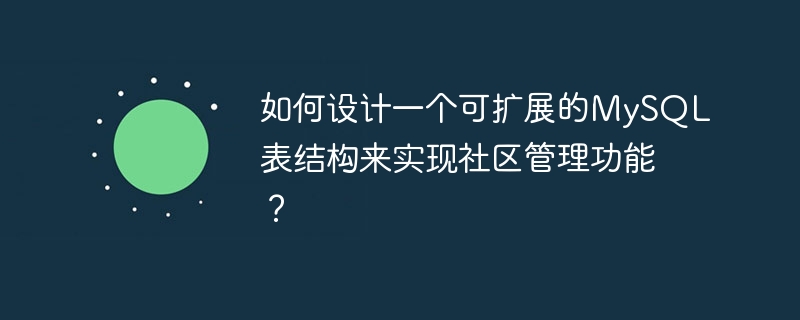Home >Database >Mysql Tutorial >How to design an extensible MySQL table structure to implement community management functions?
How to design an extensible MySQL table structure to implement community management functions?
- WBOYWBOYWBOYWBOYWBOYWBOYWBOYWBOYWBOYWBOYWBOYWBOYWBOriginal
- 2023-10-31 10:54:32878browse

How to design an extensible MySQL table structure to implement community management functions?
With the rapid development of the Internet, more and more community websites are emerging. In order to achieve an efficient and fully functional community management system, reasonable MySQL table structure design is crucial. This article will introduce a scalable MySQL table structure design solution and provide specific code examples.
1. Analysis of requirements
Before designing the table structure, we must first clarify the functional modules and requirements involved in the community management system in order to better design the table structure. A typical community management system may involve the following functional modules:
- User management: including user registration, login, permission control, etc.
- Post management: Users can publish posts, reply to posts, etc.
- Category management: Posts can be classified and displayed according to different topics.
- Tag management: Posts can be marked and searched by adding different tags.
- Like, collect and other functions: Users can like and collect posts.
- User attention and fan relationship: Users can follow other users to form fan relationships.
2. Design table structure
Based on the above demand analysis, we can design the following tables to implement community management functions:
-
User table ( user):
- id: User ID
- username: Username
- password: Password
- email: Email
- created_at: Creation time
- updated_at: Update time
-
Post table (post):
- id: Post ID
- user_id: Posting user ID
- title: Post title
- content: Post content
- category_id: Category ID
- created_at: Creation time
- updated_at: Update time
-
Category table (category):
- id: Category ID
- name: Category name
- created_at: Creation time
- updated_at: Update time
- ## Tag table (tag):
- id: Tag ID
- name: Tag name
- Post tag relationship table (post_tag):
- post_id: Post ID
- tag_id: Tag ID
- Like list (like):
- post_id: Post ID
- user_id: Like user ID
- Favorite table (favorite):
- post_id: Post ID
- user_id: Collection user ID
- User follow relationship table (follow):
- follower_id: Fan ID
- followee_id: Followed user ID
Through the above table structure design, we can realize specific community management functions. The following is sample code for common operations on the above table:
- Create user:
INSERT INTO user (username, password, email) VALUES ('Alice', '123456', 'alice@example.com'); - Publish post:
INSERT INTO post (user_id, title, content, category_id) VALUES (1, 'Hello World', 'This is the first post.', 1);
- Add tag:
INSERT INTO tag (name) VALUES ('question'); - Add post tag relationship:
INSERT INTO post_tag (post_id, tag_id) VALUES (1, 1);
- User likes the post:
INSERT INTO `like` (post_id, user_id) VALUES (1, 1);
- User favorites posts:
INSERT INTO favorite (post_id, user_id) VALUES (1, 1);
- Users follow other users:
INSERT INTO follow (follower_id, followee_id) VALUES (1, 2);
This article introduces how to design an extensible MySQL table structure to implement community management functions, and provides corresponding code examples. In actual projects, based on specific needs and business logic, the table structure can be further adjusted and optimized to achieve better performance and scalability.
The above is the detailed content of How to design an extensible MySQL table structure to implement community management functions?. For more information, please follow other related articles on the PHP Chinese website!
Related articles
See more- How to design a maintainable MySQL table structure to implement online payment functions?
- How to design a flexible MySQL table structure to implement blog comment function?
- How to design a high-performance MySQL table structure to implement geographical location function?
- MySQL table structure design for school management system: Data type selection guide

